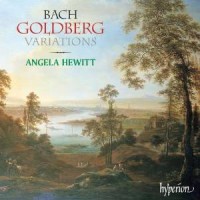J.S. Bach’s Goldberg Variations
|
Maurice Richter [July 2000. Originally appeared in La Folia 2:5.]
Bach’s Goldberg Variations are a summation of the entire history of the Baroque variation form. The music, of marvelously inspired complexity, sets forth in an aria and thirty variations a brilliant display of technical forms — canon, fugue, dances, overture, trio sonata, quodlibet and more. The aria is a stately, dignified sarabande. Bach’s absorption of the French style is manifest in its embellishments — mordents, trills, turns and grace notes — which, rather than being optional ornaments, are an essential part of the melodic line. The variations are composed on a chaconne base in sarabande rhythm and consist strictly of ten sets of two variations followed by one in canon, with the very final canon replaced by a quodlibet. The nine canons, one at every chord interval, are arranged in order of ascending intervals to move toward a climax. The first (Variation 3) is a canon at the unison, the upper voices beginning on the same note, one bar apart. The next canon (Variation 6) is a canon at the second, and so on until Variation 27, which is a canon at the ninth. This large-scale formal arrangement is utterly without precedent. The work is full of remarkable coloristic devices and keyboard complexity. It is, most of all, a work of surpassing beauty. When the initial aria returns at the end, one feels, inevitably, that an entire world has been traversed. The Goldberg Variations derive their name from the fourteen-year-old harpsichord prodigy Johann Gottlieb Goldberg who was commissioned by Bach’s often ill patron, Count Hermann Carl von Keyserlingk (who was also Goldberg’s teacher) to play to him during his frequent bouts of insomnia. Keyserlingk, the Russian ambassador to the court of Dresden, had a great passion for music and evidently commissioned Bach to write this set of variations for Goldberg to play to him during his sleepless nights. Angela Hewitt, the Canadian pianist who has given us such fine performances of Bach’s Well-Tempered Clavier, Partitas and other works on the Hyperion label surpasses herself in this new recording of the Goldberg Variations (Hyperion CDA 67305). Here are consummate mastery of technique allied with profound imagination in an endlessly fascinating interpretation of this great work. Hewitt carefully achieves a wonderful legato with her hands alone, avoiding use of the pedal. She displays enormous control of dynamics, great tonal variety and beautifully expressive playing. Hewitt plays all the repeats, often varying the voicing in the repeat so that the leading voice in the canons is brought out first, while in the repeat the voice that follows is emphasized. But that is not the only difference — the repeats frequently involve subtle differences in dynamics and phrasing, masterfully accomplished. In Variation 3, the canon at the unison, the canonic voices that follow each other immediately are played with one hand, so that it is a challenge to distinguish them sufficiently for the listener to hear their constant crossing. Hewitt elegantly tracks the separate voices she plays. In Variation 5, a brilliant toccata with much hand-crossing, her crisp articulation and fleet fingering are a joy to hear. Her exquisite touch makes Variation 7, a French gigue with dotted rhythms, a light-hearted joy. Variation 8, full of technical difficulties, also with much crossing of the hands, is played with complete command and masterful facility. The challenging Variation 14 displays formidable technique and phrasing and driving energy, the left hand boldly carving out its line. This is Bach playing that is unsurpassed. In all of these variations, Hewitt achieves a variety of color, phrasing and dynamics that are astonishing. In Variation 18 (the sixth of the canons), Bach writes his voices only half a note apart, but such is his mastery that in this most difficult form of canon, they sound as if they were the freely conceived voices of a trio sonata. Hewitt plays here with crystalline accuracy and perfect phrasing. The gymnastics of Variation 23 are a test of any pianist’s ability, and Hewitt captures the joy of the music, her technique, as always, faultless. Variation 25, which Wanda Landowska dubbed the “black pearl,” is a slow, extraordinarily expressive arioso whose painful chromaticisms demand a performance of utmost intensity and concentration, which they receive in full measure. Hewitt’s formidable technique is also manifest in the penultimate Variation 29, almost Lisztian in its virtuosic pyrotechnics. Finally, the simplicity and sensitivity with which Hewitt plays the return of the original aria after the last of the thirty variations is deeply moving, utterly transcendental. The recorded sound is clear and open and provides beautiful reproduction of the piano. This is a recording absolutely not to be missed — a major work in a superlative performance!
[More Maurice Richter, Vol. 2, No. 5]
[More
Bach]
[Previous Article:
Incredible Risks: Jazz and Improvised Music]
[Next Article:
The Complete Chamber Music of Poulenc]
|
